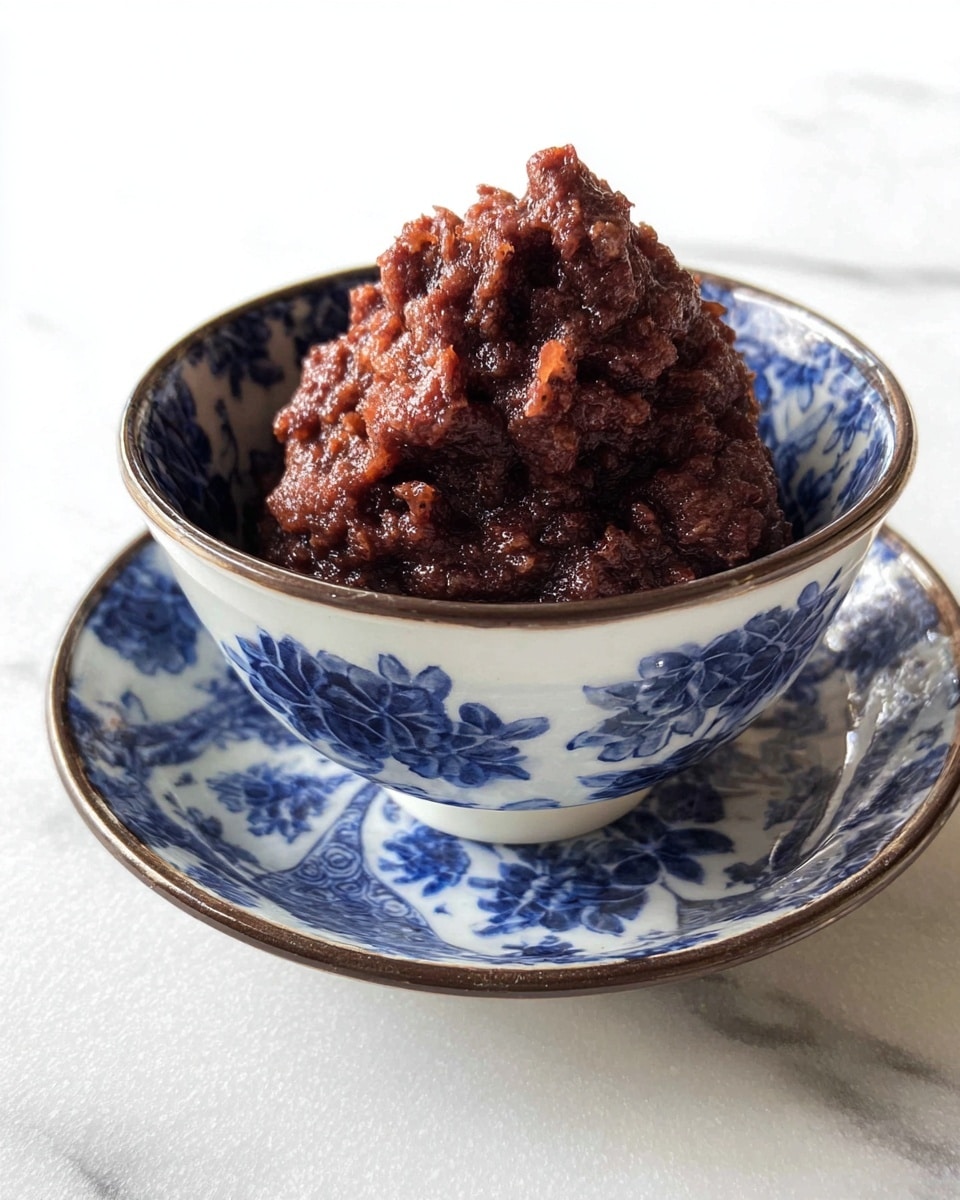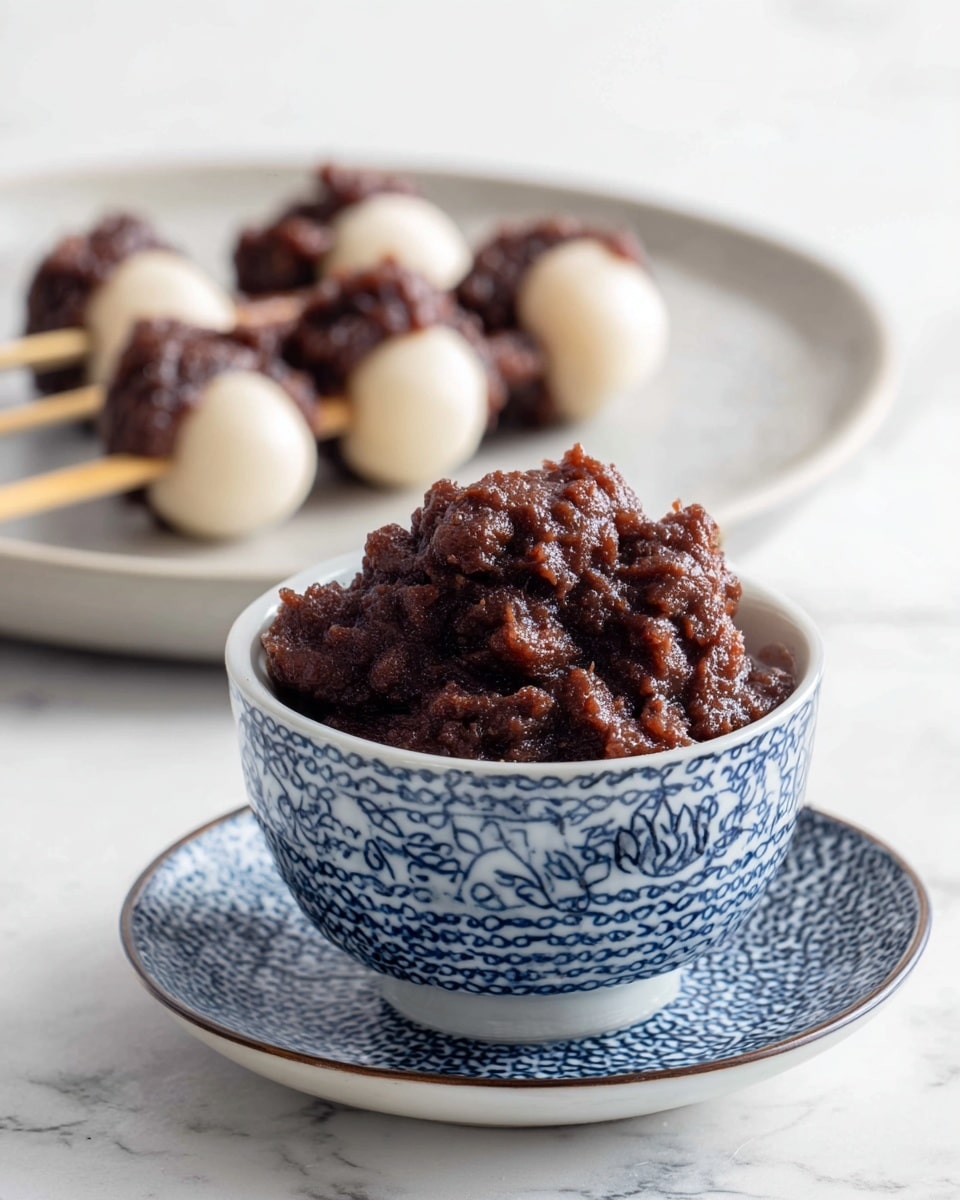Traditional Japanese Anko: Sweet Red Bean Paste Recipe
I’m so excited to share my Traditional Japanese Anko: Sweet Red Bean Paste Recipe with you. This sweet, velvety paste is a classic staple in Japanese desserts, bringing a comforting, subtly sweet flavor that just hits all the right notes. Whether you’re making mochi, dorayaki, or just want a fragrant spread to add to your breakfast toast, anko never fails to impress.
What I love most about this Traditional Japanese Anko: Sweet Red Bean Paste Recipe is how simple the ingredients are, yet the results taste so authentic and soulful. Making anko from scratch might sound intimidating, but I promise it’s easier than you think — plus, it’s wildly satisfying to watch the beans soften and sweeten right in your kitchen.
Ingredients You’ll Need
For this recipe, you just need a handful of pantry staples that come together beautifully to create that rich, sweet, and smooth anko flavor. Using quality azuki beans is key — they’re the heart and soul of this recipe!
- Azuki beans: Look for small red beans labeled “azuki” or “red mung beans.” They’re naturally sweet and soft when cooked properly.
- Sugar: Plain granulated sugar works perfectly to bring out the sweetness without overpowering the beans’ flavor.
- Salt: Just a pinch enhances the natural sweetness and balances the taste.
- Boiling water: Used to soak and cook the beans, ensuring they soften evenly without splitting.
- Water: You’ll need plenty for soaking and cooking the beans gently, helping them cook through without burning or sticking.

Variations
I like to play around with my Traditional Japanese Anko: Sweet Red Bean Paste Recipe sometimes, depending on what I’m making or who I’m serving it to. The good news is, it’s quite versatile and easy to adapt.
- Chunky vs. Smooth: For a rustic texture, I leave some beans whole, but for a silky paste, I mash everything thoroughly. Both ways taste great — just depends on your mood!
- Reduced sugar: Sometimes I dial back the sugar a bit if I’m pairing anko with something already sweet, like sweet mochi or pancakes.
- Black sugar variation: I’ve experimented with replacing white sugar with kurozato (Japanese black sugar) for a deeper, molasses-like flavor — delicious for a grown-up twist!
How to Make Traditional Japanese Anko: Sweet Red Bean Paste Recipe
Step 1: Rinse and Soak the Azuki Beans
Start by rinsing 1 cup of azuki beans under cold water until the water runs clear — this removes any dust or debris. Then, place the beans in a bowl and cover with boiling water about 1 cm above the beans. Let them soak for an hour or so; this helps soften them before cooking and cuts down on overall cooking time. I usually use this hour to prep the rest of my ingredients or tidy up the kitchen.
Step 2: Cook the Beans Gently
Drain the soaking water, then add the beans to a pot with 5 cups of fresh water. Bring to a boil over medium-high heat, then reduce to a gentle simmer. Cook uncovered for about 1 hour, skimming off any foam that rises to the surface to keep the paste clean and clear. Check beans occasionally — they should be tender but not falling apart. This slow cooking is key to that perfect creamy texture.
Step 3: Sweeten and Mash
Once the beans are tender, carefully drain any excess water, leaving enough to keep the paste moist. Add 1 cup of sugar and a pinch of salt, then return the pot to low heat. Stir continuously to dissolve the sugar and avoid burning, cooking until the mixture thickens to your desired consistency. If you want a smooth paste, mash the beans with a wooden spoon or potato masher as you stir. I like to leave just a few whole beans for texture.
How to Serve Traditional Japanese Anko: Sweet Red Bean Paste Recipe

Garnishes
I often sprinkle a little roasted sesame seeds on top of anko, adding a subtle nuttiness that complements the sweetness. Sometimes, a dollop of whipped cream makes it feel extra indulgent, especially for a modern twist on traditional desserts.
Side Dishes
Anko pairs wonderfully with mochi (rice cakes), matcha green tea, or even simple pancakes and toast. I love spreading it on fresh buttered toast for breakfast—it’s a quick way to enjoy a traditional flavor with a modern twist.
Creative Ways to Present
For special occasions, I like to use the anko as filling for homemade dorayaki (little sweet pancakes) or wrapped inside steamed buns. You can even pipe it elegantly onto dessert plates as a sauce or dollop for an eye-catching presentation. It’s a crowd-pleaser every time!
Make Ahead and Storage
Storing Leftovers
I store leftover anko in an airtight container in the fridge, where it keeps well for up to a week. Just make sure to press a piece of plastic wrap directly on the surface to prevent drying out. It’s great to have on hand for spontaneous sweets!
Freezing
Freezing anko works surprisingly well—I portion it into small silicone muffin cups, freeze solid, then transfer to a sealed bag. When you need some, just pop out a cube and thaw in the fridge. It keeps for up to 3 months this way, saving you time on future batches.
Reheating
I reheat anko gently in a small pot over low heat or microwave it in short bursts, stirring in between to retain moisture. Be careful not to overheat or it can dry out or burn. Sometimes I add a teaspoon of water if it seems too thick after reheating.
FAQs
-
Can I use canned red beans instead of azuki beans?
While canned red beans are convenient, they don’t provide the authentic flavor or texture of freshly cooked azuki beans. They can be used in a pinch, but expect a slightly different taste and a less smooth paste.
-
How do I know when my anko is done cooking?
Your anko is ready when the beans are tender all the way through and the paste has thickened to a spreadable consistency. It should hold its shape but still be moist. Taste testing along the way helps you fine-tune the sweetness and texture.
-
Is there a way to make this recipe vegan?
Good news—Traditional Japanese Anko: Sweet Red Bean Paste Recipe is naturally vegan as it mainly consists of beans, sugar, water, and salt. Just double-check your sugar source if you want to be extra certain.
-
Can I make this recipe ahead of time?
Absolutely! Anko actually tastes better the next day when the flavors have had time to meld. It stores well in the fridge or freezer, so you can enjoy this delicious paste any time you want.
-
What desserts work best with this anko?
Anko is famously used in Japanese sweets like mochi, dorayaki, and taiyaki, but don’t be afraid to get creative! It’s delicious on ice cream, pancakes, or simply spread on toast for a quick treat.
Final Thoughts
Making Traditional Japanese Anko: Sweet Red Bean Paste Recipe at home has been such a rewarding experience for me — it feels like a little taste of Japan right in my own kitchen. This recipe is heartfelt, straightforward, and results in a truly versatile paste you’ll love to use in all your sweet creations. I hope you enjoy making and sharing it just as much as I do!
Print
Traditional Japanese Anko: Sweet Red Bean Paste Recipe
- Prep Time: 10 minutes
- Cook Time: 1 hour 30 minutes
- Total Time: 1 hour 40 minutes
- Yield: About 2 cups of anko paste 1x
- Category: Sweet Paste
- Method: Stovetop
- Cuisine: Japanese
- Diet: Vegan
Description
Anko is a traditional Japanese sweet red bean paste made from azuki beans, sugar, and a pinch of salt. It is a versatile ingredient commonly used in Japanese desserts such as mochi, dorayaki, and taiyaki. This recipe guides you through cooking azuki beans until soft, sweetening them, and creating a smooth, flavorful paste perfect for various sweet treats.
Ingredients
Ingredients
- 1 cup azuki beans (200g / 7oz)
- 5 cups water
- Boiling water enough to cover the beans about 1 cm (1/2 inch) above the top
- 1 cup sugar (200g / 7oz)
- 1 pinch salt
Instructions
- Soak and rinse the beans: Rinse the azuki beans thoroughly under cold water to remove any impurities.
- Initial boil: In a pot, add the rinsed beans with enough boiling water to cover about 1 cm (1/2 inch) above the beans. Bring to a boil, then immediately drain the water to remove bitterness.
- Cook the beans: Return the drained beans to the pot and add 5 cups of fresh water. Bring it to a boil, then reduce to a simmer. Cook the beans gently for about 1 to 1.5 hours or until the beans are very soft, adding water as necessary to keep them submerged.
- Sweeten the beans: Once the beans are soft and most of the water is absorbed, add sugar and a pinch of salt to the pot. Stir well and cook over low heat until the sugar dissolves completely and the mixture thickens to a paste-like consistency.
- Cool and mash: Allow the mixture to cool slightly. For a smooth anko, mash the beans with a wooden spoon or an immersion blender to achieve your desired texture. For tsubuan style, leave some beans whole for a chunkier texture.
- Store or use: Transfer the anko to a clean container. It can be used immediately in recipes or stored in the refrigerator for up to one week or frozen for longer preservation.
Notes
- Soaking the beans overnight can reduce cooking time, but it is optional.
- Adjust sugar quantity based on your preferred sweetness level.
- Different types of anko include tsubuan (chunky) and koshian (smooth); adjust mashing accordingly.
- If the paste is too thick after cooling, add a little warm water and stir to loosen the texture.
- Use a heavy-bottomed pot to prevent burning during cooking.
Keywords: Anko,Japanese sweet red bean paste,azuki beans,traditional Japanese dessert,tsubuan,koshian







